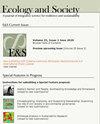关于环境变化和移民的相互作用途径,我们所知道和不知道的:来自埃塞俄比亚的教训
IF 3.2
2区 社会学
Q1 ECOLOGY
引用次数: 0
摘要
环境变化与移徙之间的联系可能是相互的:环境条件的恶化可能促使人们离开一个地方,而人们向某些地方的流动可能对自然环境产生影响,并可能增加冲突风险。尽管越来越多的研究丰富了我们对这两个主要影响方向的认识,包括冲突的作用,但实际上缺乏关于环境外移与通过迁入造成的环境退化之间动态联系的研究。为了填补这一空白,我们开发了一个概念框架,并概述了环境变化、移民、不流动和资源使用冲突的具体途径。我们将重点放在相互联系上,以了解环境变化促进向外迁移的机制,以及向内迁移如何反过来促进环境变化和资源使用冲突。框架和相应的路径基于我们对埃塞俄比亚依赖资源的农村社区的实证研究,我们将其嵌入更广泛的全球南方视角。我们确定了以下四个具体的变化途径:首先,环境变化增加了移民需求,主要是通过农业生产下降和粮食不安全,经济手段和移民经历是促成移民的关键因素。第二,环境变化增加了移徙需求,但由于照顾责任和缺乏财政资源而阻碍了移徙能力。这种缺乏抑制了移徙并导致非自愿的不动。第三,移民到农村地区通过生计转型和采用的土地管理方式引发土地利用变化和森林砍伐。第四,将感知到的资源退化归咎于移民会导致移民与当地居民之间的资源纠纷和暴力。最后,我们提出了确定和理解环境与移民相互关系的未来方向和研究重点。本文章由计算机程序翻译,如有差异,请以英文原文为准。
What we know and do not know about reciprocal pathways of environmental change and migration: lessons from Ethiopia
Linkages between environmental change and migration can be reciprocal: declining environmental conditions can trigger people to leave a place, while the movement of people to certain places can have implications for the natural environment and may enhance conflict risks. Although a growing body of research has enriched our knowledge on these two main directions of influence, including the role of conflict, research on dynamic linkages between environmental out-migration and degradation through in-migration is virtually lacking. To fill this gap, we have developed a conceptual framework and have outlined specific pathways of environmental change, migration, immobility, and resource use conflicts. We focus on reciprocal linkages to understand the mechanisms through which environmental change contributes to out-migration and how in-migration, in turn, may contribute to changes in the environment and resource use conflicts. The framework and corresponding pathways are based on our empirical research on resource-dependent rural communities in Ethiopia, which we have embedded in a broader Global South perspective. We identified the following four specific pathways of change: first, environmental change increases migration needs, primarily through declining agricultural production and food insecurity, with financial means and migration experiences being key factors enabling migration. Second, environmental change increases migration needs but hampers migration abilities through care responsibilities and lack of financial resources. This lack inhibits migration and leads to involuntary immobility. Third, migration to rural areas triggers land use change and deforestation through livelihood transitions and adopted land management in receiving areas. Forth, blaming migrants for perceived resource degradation contributes to resource disputes and violence between migrants and the local population. We conclude with future directions for identifying and understanding reciprocal environment-migration linkages and priorities for research.
求助全文
通过发布文献求助,成功后即可免费获取论文全文。
去求助
来源期刊

Ecology and Society
环境科学-生态学
CiteScore
6.20
自引率
4.90%
发文量
109
审稿时长
3 months
期刊介绍:
Ecology and Society is an electronic, peer-reviewed, multi-disciplinary journal devoted to the rapid dissemination of current research. Manuscript submission, peer review, and publication are all handled on the Internet. Software developed for the journal automates all clerical steps during peer review, facilitates a double-blind peer review process, and allows authors and editors to follow the progress of peer review on the Internet. As articles are accepted, they are published in an "Issue in Progress." At four month intervals the Issue-in-Progress is declared a New Issue, and subscribers receive the Table of Contents of the issue via email. Our turn-around time (submission to publication) averages around 350 days.
We encourage publication of special features. Special features are comprised of a set of manuscripts that address a single theme, and include an introductory and summary manuscript. The individual contributions are published in regular issues, and the special feature manuscripts are linked through a table of contents and announced on the journal''s main page.
The journal seeks papers that are novel, integrative and written in a way that is accessible to a wide audience that includes an array of disciplines from the natural sciences, social sciences, and the humanities concerned with the relationship between society and the life-supporting ecosystems on which human wellbeing ultimately depends.
 求助内容:
求助内容: 应助结果提醒方式:
应助结果提醒方式:


